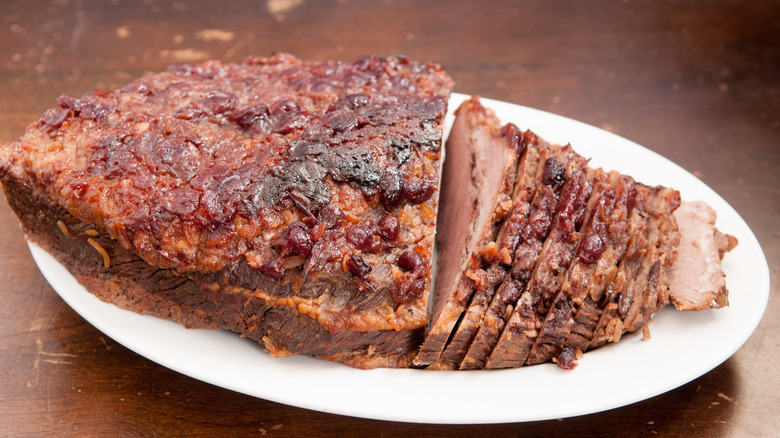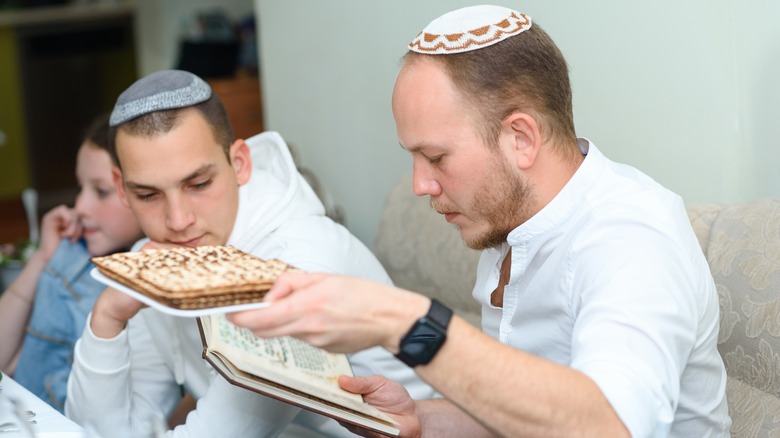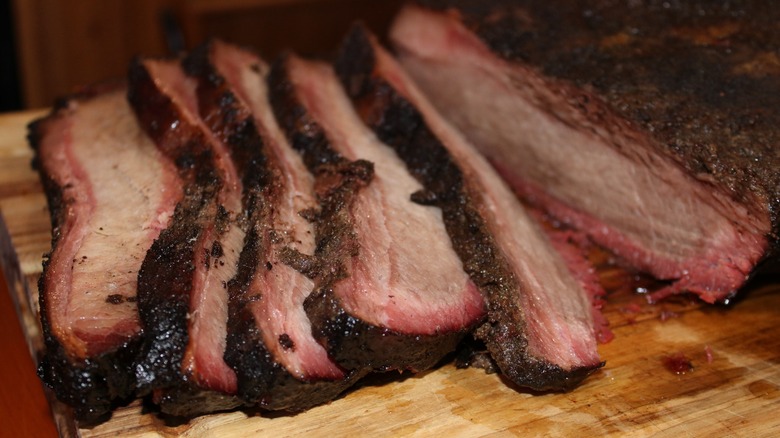How Brisket Became A Staple Dish To Serve On Jewish Holidays
There are a lot of Jewish holiday traditions, some of which may be familiar to non-gentiles and some of which probably aren't at all. Drinking is a huge part of multiple religious celebrations; Passover involves numerous cups of wine as part of the ceremony itself, and on Purim, you're supposed to drink so much you cannot tell the difference between cursing Haman (the villain of the Purim story) and blessing Mordechai (one of its heroes). The celebration of trees is another recurring theme (there's even a holiday called Tu BiShvat that is basically Jewish Arbor Day). And, of course, there's the traditional food.
But while most gentiles are probably aware of latkes, they might not be aware of the single most significant Jewish holiday staple, the one that appears at nearly every major holiday other than — for obvious reasons — Yom Kippur. Every single Jewish person knows what dish we're talking about because if you were raised Jewish, you absolutely ate brisket at major holiday gatherings.
Wait, brisket? The barbecue cut that Texans lose their minds over? Yes, long before brisket was a part of every pit master's greatest aspirations, it was a core part of the Jewish cultural identity. How did brisket become this important? The answer, like most foods, comes down to economics.
Brisket started as a humble, cheap cut of meat
Brisket may now be considered the king of smoked meats, but it wasn't always that way. For a long time in Central and Eastern European history, brisket was one of the cheapest cow cuts you could possibly find owing to its general toughness as a particularly muscular, lean cut of beef. Since the laws of Kosher forbid pork (and even part of the cow), and most Jewish families were not particularly wealthy, this made brisket a natural choice for Jews to feed their families. (As a side note, this isn't even the only time a food has gone from being seen as valueless to a delicacy: Something similar once happened with lobster.)
Since nobody else wanted it, Jewish cooks were the first to really figure out what to do with brisket and learn the importance of slow-cooking it to break down its connective tissues. Typically, Jewish brisket is braised rather than the smoked variety most Americans know it under for barbecue. Still, the principle is the same: You don't expose brisket to high heat. But while brisket had been a holiday food for Jews since its adoption (its large size and long cooking times meant it wasn't suitable as an everyday protein), it was the mass immigration of Jews to America starting in the late 19th century that really cemented its place in the Jewish cultural lexicon.
Jewish immigrants to America carried on the brisket tradition
When these same Jews were largely expelled from Europe during the late 19th century amidst a wave of pogroms and discrimination, many of them came to America and brought their love of brisket with them. It turned out beef was cheaper and more accessible in America, and the increased economic opportunities for immigrants meant many Jews could afford more expensive cuts. But, every holiday and gathering, they returned to the staple that had come to define Jewish gatherings: brisket. During the continuing wave of Jewish immigration in the 1930s and '40s, many Jews settled in Texas, particularly in the larger cities, and many of them opened delis. The resulting cross-cultural blending of Jewish and Southern cooking techniques ultimately produced the slow-smoked barbecue brisket we know today.
Today, whether you're talking about Rosh Hashanah, Passover, Hanukkah, or whatever other holiday, Jewish families are all but guaranteed to eat brisket. Maybe you didn't know that before today, but now you do.


